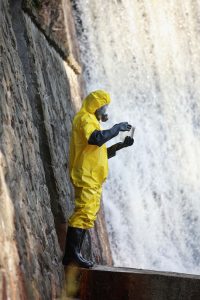Next year will be the 50th Anniversary of Earth Day! The first Earth Day occurred on April 22, 1970, and I will show my age and admit that I clearly recall marching around my little campus on a blustery spring day in Topeka. Now, 49 years later, we want to celebrate Earth Day by highlighting some jobs that take care of our planet.
One way we keep track of jobs in the United States is through the Occupational Outlook Handbook which provides career information for hundreds of occupations. The Occupational Outlook Handbook was first published in 1949 to serve returning veterans of World War II. This year, the Handbook is 70 years old!
In honor of Earth Day, here are six earth-friendly career paths to consider:
Agricultural Engineers
What they do: Solve agricultural problems concerning power supplies, the efficiency of machinery, the use of structures and facilities, pollution and environmental issues, and the storage and processing of agricultural products. 
- 2018 median pay: $77,110 per year
- Typical entry-level education: Bachelor’s degree
- Number of jobs 2016: 2,700
- Projected growth. 2016–26: 8% (As fast as average)
Environmental Engineering Technicians
What they do: Test, operate, and, if necessary, modify equipment used to prevent or clean up environmental pollution. They may collect samples for testing, or they may work to mitigate sources of environmental pollution. 
- 2018 median pay: $50,560 per year
- Typical entry-level education: Associate’s degree
- Number of jobs 2016: 17,000
- Projected growth, 2016–26: 13% (Faster than average)
Biochemists & Biophysicists
What they do: Study the chemical and physical principles of living things and of biological processes, such as cell development, growth, heredity, and disease. 
- 2018 median pay: $93,280 per year
- Typical entry-level education: Doctoral or professional degree
- Number of jobs 2016: 31,500
- Projected growth, 2016–26: 11% (Faster than average)
Atmospheric Scientists, including Meteorologists
What they do: Study the weather and climate, and examine how those conditions affect human activity and the earth in general. ![]()
- 2018 median pay: $94,110 per year
- Typical entry-level education: Bachelor’s degree
- Number of jobs 2016: 10,400
- Projected growth, 2016–26: 12% (Faster than average)
Solar Photovoltaic (PV) Installers
What they do: Assemble, install, and maintain solar panel systems on rooftops or other structures. 
- 2018 median pay: $42,680 per year
- Typical entry-level education: High school diploma or equivalent
- Number of jobs 2016: 11,300
- Projected growth, 2016–26: 105% (Fastest of the more than 800 occupations BLS projects)
Environmental Scientists & Specialists
What they do: Use their knowledge of the natural sciences to protect the environment and human health. They may clean up polluted areas, advise policymakers, or work with industry to reduce waste. 
- 2018 median pay: $71,130 per year
- Typical entry-level education: Bachelor’s degree
- Number of jobs 2016: 89,500
- Projected growth, 2016–26: 11% (Faster than average)
Want more information? You can explore hundreds of occupations using our Occupational Outlook Handbook. For a larger list of new and emerging earth-friendly or “green” jobs, visit the Department of Labor’s O*Net Resource Center.
 United States Department of Labor
United States Department of Labor